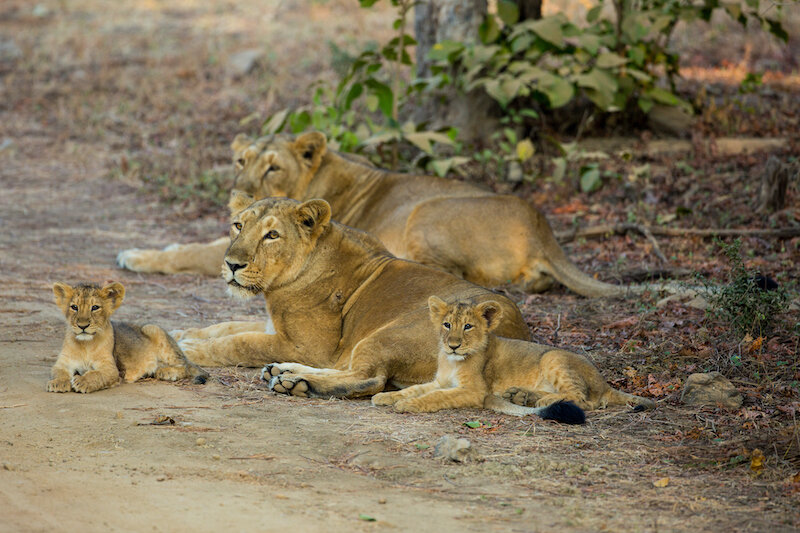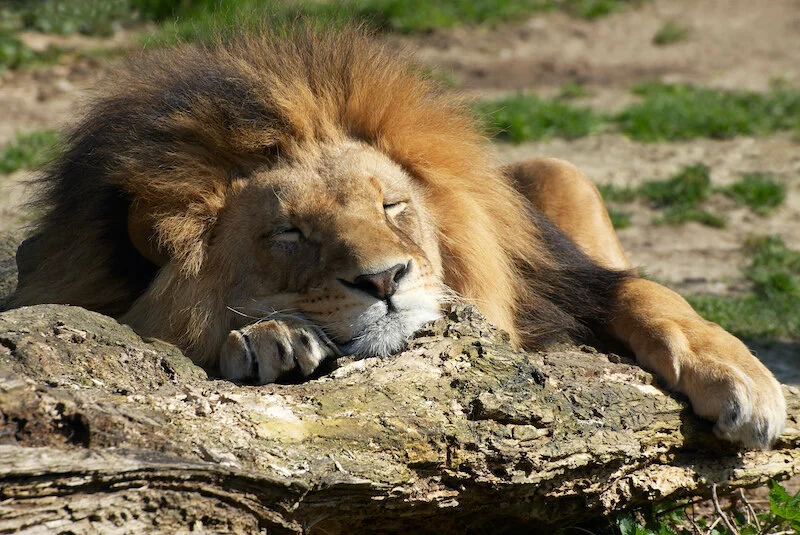Lions are big cats.
The hair on a male lion's head is called a mane.
The females do most of the hunting for food.
They work as a team when they hunt.
Lions live in family groups called prides.
What is a lion?
Lions are mammals. They are part of the group of cats known as the 'big cats'.
However, lions are different from other cats because they live in large social groups, called prides, and are the only cats to do so. Other cats are generally solitary, which means they live alone most of the time.
A small pride of African lions resting ©Getty Images
Today most lions are found in Africa, although there is another subspecies (kind) found in India (Asiatic lions).
Asiatic females and cubs of a pride ©Getty
The term subspecies means they are almost the same but there are small differences because they have lived in different places for thousands of years.
Habitat and Distribution (where lions are found)
The African lion is found in parts of eastern and southern Africa. They are generally protected in reserves, although hunting by humans still occurs.
The Asiatic, or Asian, lion, which was once found all over India, the Middle East and Southern Asia, is today found only in the Gir Forest National Park in Gujarat, western India. This is a sanctuary area, and because of captive breeding programs that release lions back into the Gir, there are now about 400. This is an increase in numbers, thanks to the excellent conservation actions taken by the Indian Government.
Lion habitat is grasslands and open woodlands where there are belts of trees and bush near rivers.
They are rarely found in forests with a thick canopy - lions are often called 'King of the Jungle' but they actually live on grasslands!
Social Organisation and Behaviours
Lions mostly live in a group. A group of lions is called a pride, generally consisting of up to around fifteen (but can be up to about thirty or more) lions, mostly females that are related. One male, or sometimes two or three males, join a pride and stay for a period of time, usually about three years or until another male or group of males take over the pride.
Females and cubs of a pride drinking at a waterhole. © Getty
A pride is territorial, and the males mark the territory with scent and by roaring. Roaring is also a way for members of a pride to stay in touch when they are in different parts of their territory. A lion's roar can be heard up to 8kms away, and close to the roaring lion, the grass flattens and leaves move on the trees from the force of the sound!
Because meat is filling, carnivores don't need to eat every day, and rest to let their food digest. Lions spend about 20 hours a day sleeping.
Lions rest for about 20 hours a day. ©Getty
The habitat of Asiatic lions is very harsh, and prey is more scarce, so they live in smaller prides so there are fewer mouths to feed. They rarely have more than two females in a pride. The males are less social than African lion males, and only associate with the pride for feeding and for mating.
Physical Features
Male African lion giving a warning. ©Getty Images
Lions are generally a light, yellowish-brown colour. Male African lions have a long thick hair called a mane on their heads, cheeks and throat, and often on shoulders and belly also, while females do not. The manes protect them from bites and wounds while fighting. A darker mane indicates an older lion. On average, the males are about 3 metres long, and females about 2.5 metres long, both with tails of about 100 cm.
There is a tuft of fur at the end of the tail. Males weigh about 250 kg and females about 180 kg.
An Asiatic male lion. Asiatic lions have smaller manes than those of African lions. ©Getty Images
Asiatic lions are smaller than African ones. The male Asiatic lion has a smaller mane compared to that of the African male.
Both male and female Asiatic lions have a long fold of skin running the length of the belly, which is a feature not found on the African lions.
Diet
Lions are carnivores, which means they eat meat.
Females work as at team to hunt prey ©Getty Images
The females do almost all of the hunting, generally working as a team. In Africa they hunt animals such as wildebeest, waterbuck, zebra, impala, and sometimes giraffe. They will also feed on smaller animals such as hares, birds and reptiles.
Lions can run at about 35 km per hour but only in short bursts. Therefore they work as a team to stalk and capture prey, so that as one tires, another takes the lead. Lions have excellent vision and can spot prey at some distance.
They depend on stalking to get as close as possible to their prey before having to chase. The pads on their feet enable them to move soundlessly. Their sharp, retractable claws are important for seizing and holding prey. 'Retractable' means they can pull them in or have them out when needed. This keeps them sharper.
A female stalking prey ©Getty Images
Males eat first, then the females and lastly the cubs. Lions can eat up to around 40kg of meat at one meal, then they don't need to hunt or eat for a couple of days. Lions can therefore spend a great deal of time sleeping.
Asiatic lions prey on deer (there are two kinds in Gir: chital and sambar deer), antelope, wild boar and other smaller animals.
Females with cubs ©Getty Images
Life Cycle
About 100-119 days after mating with a male, a female lion gives birth to about 2 or 3 cubs. Young cubs are marked with light spots which gradually disappear as they grow. After a few weeks they begin eating meat.The cubs remain with their mother for at least two years. They begin hunting at 11 months.
A trio of very young cubs ©Getty
Cubs play with each other and with adult members of the pride, including males. When females go off to hunt, one will stay to 'babysit' all the cubs of the pride.
When male cubs are about one year old, they leave the pride and become 'rogue' males until they are older and stronger and able to fight and take over a pride, driving out the male or males they have defeated. When a new male takes over a pride, one of the first things he does is to kill all the cubs. He then mates with the females so that in a few months all the cubs in the pride will be his young.
Male African lion and cubs ©Getty Images
Conservation status and Threats
Threats to lions include loss of habitat because of human population growth and development, as well as hunting and poisoning by farmers whose livestock are killed by lions. African lions are classified as Vulnerable by the International Union for the Conservation of Nature (IUCN), which says African lions face a high risk of extinction in the wild in the near future. Asiatic lions are classified by the IUCN as Endangered, and faces a very high risk of extinction in the wild in the near future.
Two species of lion, the Barbary lion (which was the largest of all the lion species) and the Cape lion are now extinct.
The extinct Barbary lion.©Getty
It’s a good idea to get information from more than one source!
Read more about African lions:
Read more about Asiatic lions:
https://www.wwfindia.org/about_wwf/priority_species/threatened_species/asiatic_lion/
Watch a video about lions:
More educational lessons on Mammals at NeoK12.com














